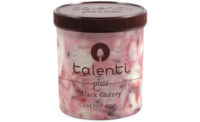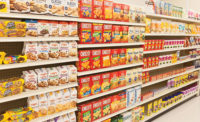National vs. Retail Brands: Winning the Battle at the Shelf
As retailers move from knockoff designs to knockout branding, national labels work to keep up.


Across categories, the packaging of leading brands must work harder than ever to justify price premiums against increasingly compelling private label competitors.

Pack sizing is one effective way to impact the value equation and give shoppers a reason to pay a bit more.

The redesign of Kraft Mac & Cheese successfully distanced the brand from private label competitors by injecting personality and linking to broader marketing efforts.




Over the past decade, private labels have travelled the long road from neglected stepchildren to central components of many retailers’ business strategies. As retailers have embraced “own brands” as a driver of profit and shopper loyalty, there’s been a stunning transformation in the packaging of these brands. Retailers now realize that private label doesn’t need to look cheap in order to convey value, nor does it need to mimic the appearance of national brands to suggest comparable quality. Leaders such as Target and Safeway have used their up & up and O Organics lines respectively to abandon knockoff design strategies in favor of more sophisticated, branded approaches that highlight the visual cues associated with well-established national brands — prominent branding, compelling visuals and even structural innovation.
Without question, this revolution in retail branding has placed an increased burden on national brands, which must work harder than ever to justify price premiums. In particular, they’ve been forced to raise the bar on their packaging to compete at the point of sale against increasingly compelling private label brands.
At PRS, we are fortunate to work with many leading CPG companies facing this challenge, in categories ranging from food and beverages to OTC medications and household products. Recently, we reviewed our database and conducted a meta-analysis across studies to see what it would reveal about competing more effectively against retail brands.
>FOUR GUIDING PRINCIPLES
Across categories and brands, several core principles have emerged from our studies that translate into a set of guidelines for the packaging of brands facing a private label threat.
1. Leverage distinctive visual assets
Certainly, private brands have several built-in advantages in the battle at retail, most notably lower pricing and, increasingly, more favorable shelving. However, national brands also have a major, and perhaps more subtle, factor working in their favor: the power of habit.
Many categories with a strong private label presence are frequent and habitual purchases in which shoppers typically don’t invest a great deal of energy. In fact, our in-store studies done with PRS Mobile Eye-Tracking have consistently revealed that shoppers are largely on autopilot in these aisles. With low levels of comparison shopping and a high correlation between visibility and purchase, shoppers often buy the first brand that they actively consider. In these cluttered low-engagement categories, people are looking for familiar visual cues (colors, icons, shapes, etc.) to help them “deselect” products and narrow their choices to simplify the shopping experience.
The implication for packaging is quite clear: National brands need to build and highlight familiar visual assets (think of Tide’s orange hue or Special K’s icon), which create visibility and link to brand recognition. By leveraging familiarity — or, if possible, creating “mini-sections” — in the aisle, they can often preempt private label competition, reinforce well-established shopping habits and discourage comparison shopping.
2. Connect emotionally
A second, related strategy is for national brands to leverage fully the power of their usage history and advertising budgets in the aisle. To be clear, this doesn’t necessarily require linking the packaging directly to the brand’s latest promotional campaign. However, it does involve evoking the underlying emotion behind the brand, typically via compelling visuals (the Pampers baby, the Purina pet) that focus on the end user or end benefit rather than the product itself. Alternatively, this approach can involve capturing the essence of the brand through a truly unique design aesthetic (a distinctive voice), familiar icons that convey personality (such as the M&M’S characters), or even a particularly compelling on-pack promotion (linked to Web-based content, special events, etc.).
While the executional strategy may vary, the overriding objective is consistent: to discourage a purely rational decision based on price and quantity by speaking to higher-level motivations (or simply by evoking a smile). The redesign of Kraft Mac & Cheese stands as a successful case in point as it injected personality into the brand and dramatically enhanced its positioning vis-à-vis retail brands.
3. Highlight a point of difference
Beyond the visual and visceral levels, packaging also needs to differentiate and compete at the rational level. Specifically, it needs to give shoppers a reason to spend a bit more as opposed to going with the lower-priced store brand. Here, marketers often misstep in one of two ways: They rely solely on the power of branding to justify the price premium, or they clutter the packaging with too much messaging, which prevents them from conveying a clear point of difference or superiority. Both strategies are misguided, as across studies:
- We’ve found that brands highlighting a primary on-pack claim are far stronger in perceived superiority to private label (i.e., worth paying more for), which translates to higher levels of purchase from shelf.
- We’ve seen that adding extra claims to a pack typically reduces shoppers’ visual engagement with the primary claim (as documented by PRS Eye-Tracking), which weakens its impact.
While it is difficult to generalize across brands and categories about messaging content, we can say that it’s critical to prioritize a lead claim and ensure its visibility. In fact, we’ve worked with many marketers to develop consistent guidelines for the placement and presentation of on-pack messaging.
4. Add value via packaging innovation
Finally, perhaps the most effective strategy is to change the value equation through packaging structure, functionality or sizing. New pack structures are not only inherently more proprietary and “protectable” than graphics, but also they can make a difference with shoppers on multiple levels — from the shelf through the usage experience — by influencing visibility, imagery, price/value perceptions, usage rates and more.
At PRS, we are often asked which innovations really matter to shoppers (i.e., what shoppers will pay more for). Here, the quick answer is that shoppers typically place the greatest value on innovations that link most directly to their value equation:
- By reducing the amount of wasted product (via resealability or full product dispensing)
- By speaking directly to usage occasions (on-the-go packs)
- By offering additional product at the same price (“Get More Free”)
Of course, the final point has been discovered by many marketers, which is why we now see large yellow “15% More Free” stickers proliferating in nearly every aisle. However, many companies don’t know that there are very consistent ways in which pack sizing impacts price/value perceptions. In joint research with Professor Pierre Chandon of INSEAD, we’ve uncovered that across categories, shoppers consistently perceive package changes in one dimension (taller or wider) more dramatically than changes in three dimensions (taller, wider and deeper). This has direct implications for maximizing value perceptions, as marketers are well advised to upsize their packaging in one dimension (make it taller or wider) — and to downsize packaging in three dimensions (make it shorter, narrower and thinner in a proportional manner).
>BUILDING PRIVATE LABEL INTO DEVELOPMENT & RESEARCH
The guiding principles above represent a starting point and framework for thinking about the battle against private label: Is the current packaging working hard enough? How can differentiation be increased? But to compete effectively on a consistent basis across brands and retail channels, marketers need to incorporate knowledge of private label design strategies into their packaging development and research processes. To that end, we can suggest three best practices.
1. Start with the design brief
A strong brief is the foundation for successful packaging — and at PRS, we’ve long argued that design briefs should incorporate and illustrate key retail realities such as shelving, lighting and POS that impact how packaging appears to shoppers. Clearly, private label is an important component of this effort: Marketers and designers need to understand (and ultimately design against) a wide range of store brand competitors, which vary across retailers in appearance, shelving and POS support. They need to know the strategies of the primary retail competitors: Are they copycats or store brands? Are they brand blocked or interspersed? Do they make directly competitive claims on pack or POS? Does their packaging have functional limitations? While it may not be possible to design for each scenario, this process helps teams to identify the most challenging situations and prioritize efforts accordingly.
2. Incorporate retail brands within packaging development & research
After in-store research has identified several lead competitors, it is important to incorporate these competitors and competitive contexts into the decision-making process. At PRS, we often start by creating digital versions of different retailer planograms. This allows designers to drop in proposed packaging systems and provides a visual reality check through the development process (e.g., How would this packaging look next to Great Value on the Walmart shelf?).
Later, when we conduct on-shelf qualitative and quantitative research with shoppers, we often use two to three different planograms (with varying private label packaging, shelving and/or POS presence) to gauge visibility, shopability and purchase patterns. In follow-up attitudinal interviewing (upon direct exposure to packaging), there’s often a focus on differentiation from private label, particularly across the core dimensions that link most directly to sales (perceived superiority, price/value perceptions and likelihood of confusion). Importantly, we have shoppers react to the full proposition of packaging and pricing, and then we probe specifically to understand if the packaging is justifying its price premium.
3. Commit to packaging innovation
Finally, given the importance of innovation in competing against private label, it is critical for marketing to commit to exploring new packaging structures, sizes and delivery systems. This commitment goes beyond increasing the budget for R&D: It also involves developing a shopper research process that measures/quantifies the full value of packaging innovations, particularly in differentiating brands from their private label competitors at the shelf, in hand and in home. It also involves investing in physical package comps for research — to accurately gauge price/value perceptions, particularly when upsizing or downsizing — and ensuring that on-pack claims are clearly highlighting new packaging features/benefits.
>WINNING AT THE SHELF
While marketers typically focus their attention on brand building through advertising, promotions and social media, the reality is that their brands will largely succeed (or fail) at the retail shelf, where most purchase decisions are made. At that shelf, they will find far stronger private label competitors than ever before, with more compelling packaging, better product quality and often a considerable pricing advantage. Without question, retail brands have raised their game and been rewarded with share gains. To win back lost ground, leading CPG manufacturers will need to do the same by acknowledging the challenge, adjusting their competitive mindsets and developing the right processes to bring more effective packaging to market. Those that do so will be rewarded with packaging that allows their brands to justify price premiums and maintain market share.
Looking for a reprint of this article?
From high-res PDFs to custom plaques, order your copy today!










